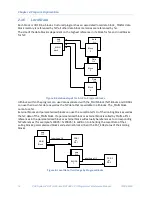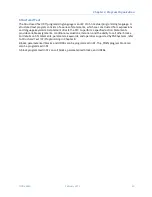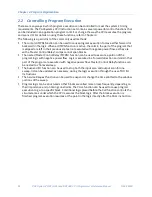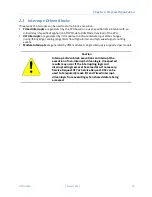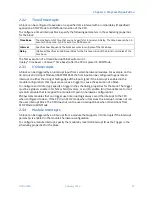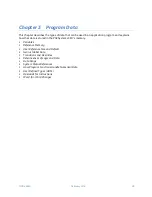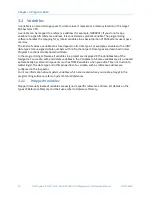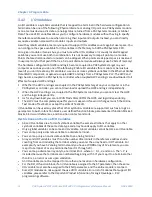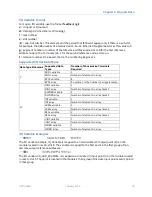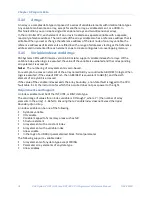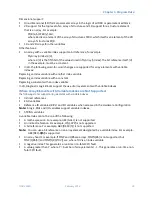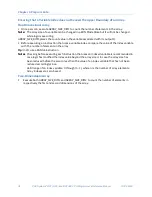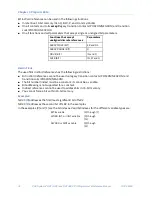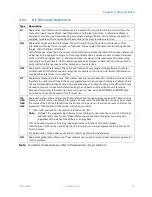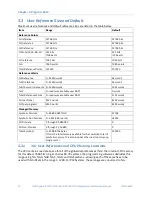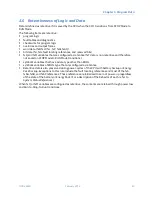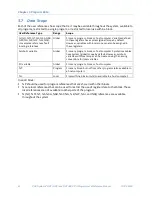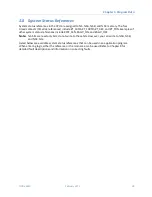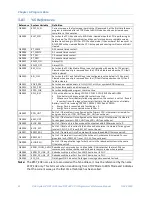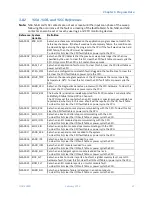
Chapter 3. Program Data
32
PACSystems* RX7i, RX3i and RSTi-EP CPU Programmer's Reference Manual
GFK-2950C
3.1.3
I/O Variables
An I/O variable is a symbolic variable that is mapped to a terminal in the hardware configuration. A
terminal can be one of the following: Physical discrete or analog I/O point on a PACSystems module
or on a Genius device, a discrete or analog status returned from a PACSystems module, or Global
Data. The use of I/O variables allows you to configure hardware modules without having to specify
the reference addresses to use when scanning their inputs and outputs. Instead, you can directly
associate variable names with a module’s inputs and outputs.
As with symbolic variables, memory required to support I/O variables counts against user space. You
can configure the space available for I/O variables in the Memory tab of the PACSystems CPU.
For a given module or Genius bus, you must use either I/O variables or manually located mapped
variables: you cannot use both in combination. It is not necessary to map all points on a module.
Points that are disconnected or unused can be skipped. When points are skipped, space is reserved
in user memory for that point (that is, a 32-point discrete module will always use 32 bits of memory).
The hardware configuration (HWC) and logic become coupled in a PACSystems target on your
computer as soon as you do one of the following: Enable I/O variables for a module or Genius bus
(even if you don't create any I/O variables), use one or more symbolic variables in the Ethernet Global
Data (EGD) component, or upload a coupled HWC and logic from a PACSystems PLC. The HWC and
logic become coupled in a PACSystems controller when coupled HWC and logic are downloaded to it.
Effects of coupled HWC and logic:
▪
Whether the HWC and logic are coupled in the PACSystems target on your computer or in the
PACSystems controller, you cannot download or upload the HWC and logic independently.
▪
When the HWC and logic are coupled in the PACSystems controller, you cannot clear the HWC
and the logic independently.
▪
As for any download, you cannot
RUN Mode Store
(RMS) the HWC and logic independently.
▪
The HWC must be completely equal for you to make word-for-word changes, launch the Online
Test mode of Test Edit, or accept the edits of Test Edit.
I/O variables can be used any place that other symbolic variables are supported, such as in logic as
parameters to built-in function blocks, user defined function blocks, parameterized function blocks, C
blocks, bit-in-word references, and transition contacts and coils.
Restrictions on the Use of I/O Variables
▪
Since I/O variables are a form of symbolic variable, the same restrictions that apply to other
symbolic variables of the same data type and array bounds apply to I/O variables.
▪
Only a global variable can become an I/O variable. A local variable cannot become an I/O variable.
▪
You can map only a discrete variable to a discrete terminal.
▪
You can map only a non-discrete variable to an analog terminal.
▪
Arrays and UDT variables must fit on the number of terminals in the reference address node
counting from and including the terminal where you enter the array head or UDT variable. For
example, if you have 32 analog terminals and you have a WORD array of 12 elements, you can
map it to terminal 21 or any terminal before it (1 through 20).
▪
You can map a discrete array only to a terminal 8n+1, where n = 0, 1, 2, and so on. The "+1" is
included because the terminals are numbered beginning with 1. If you map it to a terminal other
than 8n+1, an error occurs upon validation.
▪
An I/O variable cannot be mapped to more than one location in hardware configuration.
▪
For the DO_IO function block, if an I/O variable is assigned to the ST parameter, then the same
I/O variable must also be assigned to the END parameter, and the entire module is scanned.
▪
Some I/O modules do not support the use of I/O variables. For a list of modules that support I/O
variables, please refer to the
Important Product Information
for Logic Developer
–
PLC
programming software.
Summary of Contents for PACSystems RX7i
Page 357: ......
Page 466: ...Chapter 9 Diagnostics GFK 2950C February 2018 451...

